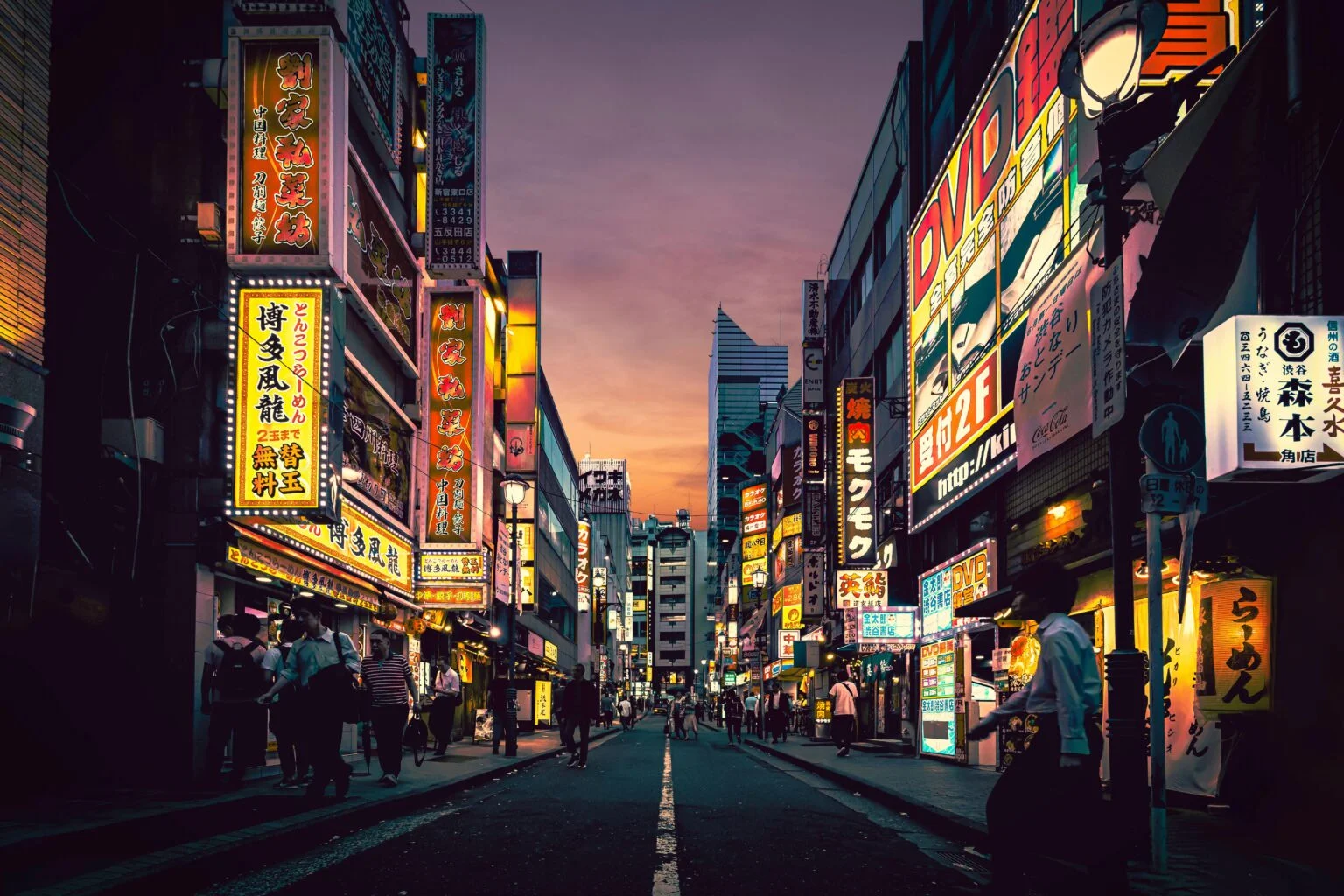Planning a trip to Japan requires careful consideration of when to go. The best time to visit Japan varies significantly depending on your interests, budget, and tolerance for crowds. This fascinating country offers distinct experiences in each season, from the world-famous cherry blossoms of spring to the vibrant autumn foliage, refreshing summer festivals, and snow-covered winter landscapes. Understanding Japan’s seasonal rhythms is key to crafting your perfect Japanese adventure.
What they have done in Japan, which I find so inspirational, is they’ve brought the toilet out from behind the locked door. They’ve made it conversational.
Rose George
In this comprehensive guide, we’ll explore Japan’s four distinct seasons, highlighting the unique experiences each offers. Whether you’re dreaming of photographing Mount Fuji framed by pink sakura, experiencing traditional matsuri festivals, hiking through colorful autumn landscapes, or soaking in an onsen while snow falls outside, we’ll help you determine the ideal time for your Japanese journey based on your personal preferences and travel style.

Image: Cherry blossom trees in full bloom with Mount Fuji in the background
I. Understanding Japan’s Four Seasons: When to Experience Each
Japan experiences four distinct seasons, each offering unique attractions and experiences. The country’s geography, stretching from the snowy northern island of Hokkaido to the subtropical southern islands of Okinawa, means that weather conditions can vary dramatically depending on where you visit.
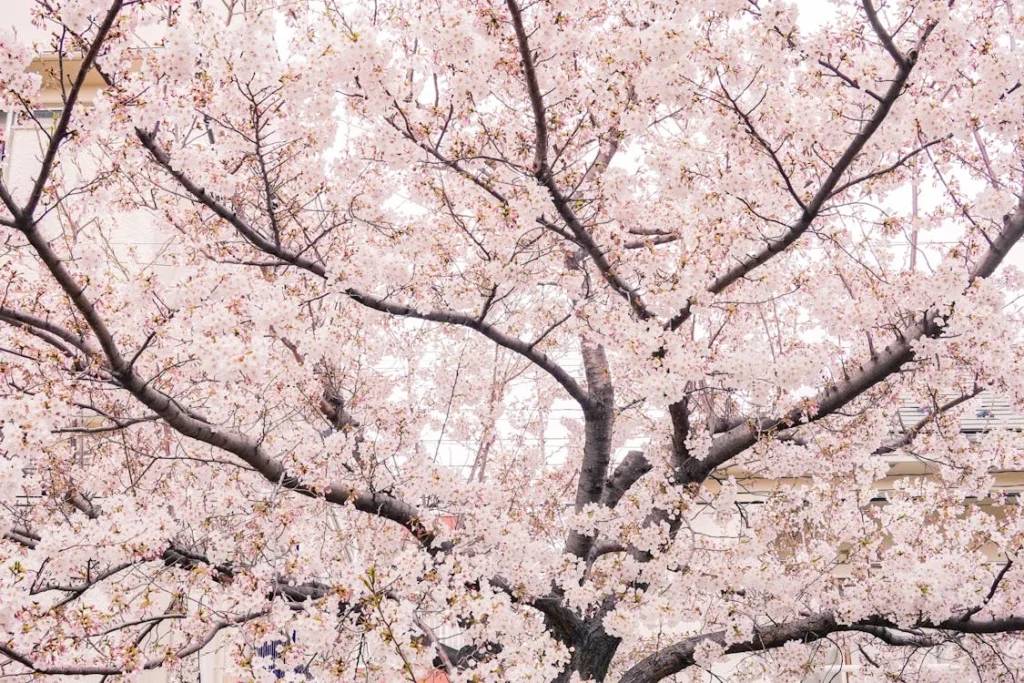
Japan Spring Travel: Cherry Blossoms and Mild Weather (March-May)
Spring is arguably the most popular time for Japan travel, and for good reason. This season brings mild temperatures, blooming flowers, and the iconic cherry blossoms that have become synonymous with Japanese culture.
Cherry Blossom Season Japan: Timing the Perfect Hanami
The cherry blossom season Japan experience, known locally as “sakura,” typically begins in late March and continues through early April, though exact timing varies by location:
- Southern Japan (Kyushu, Shikoku): Late March
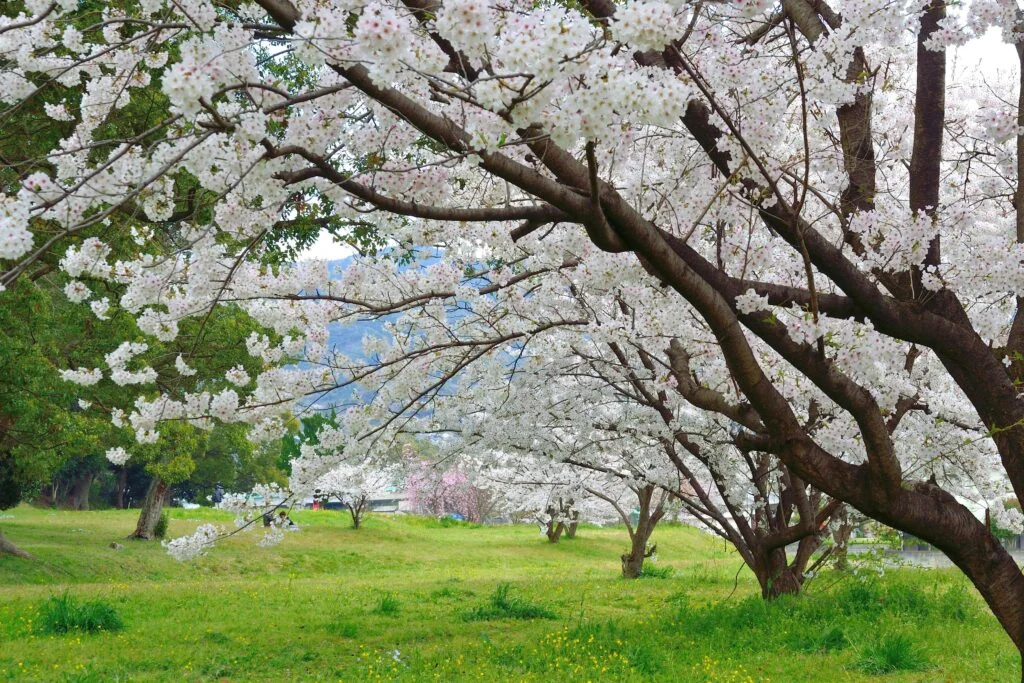
- Central Japan (Tokyo, Kyoto): Late March to early April
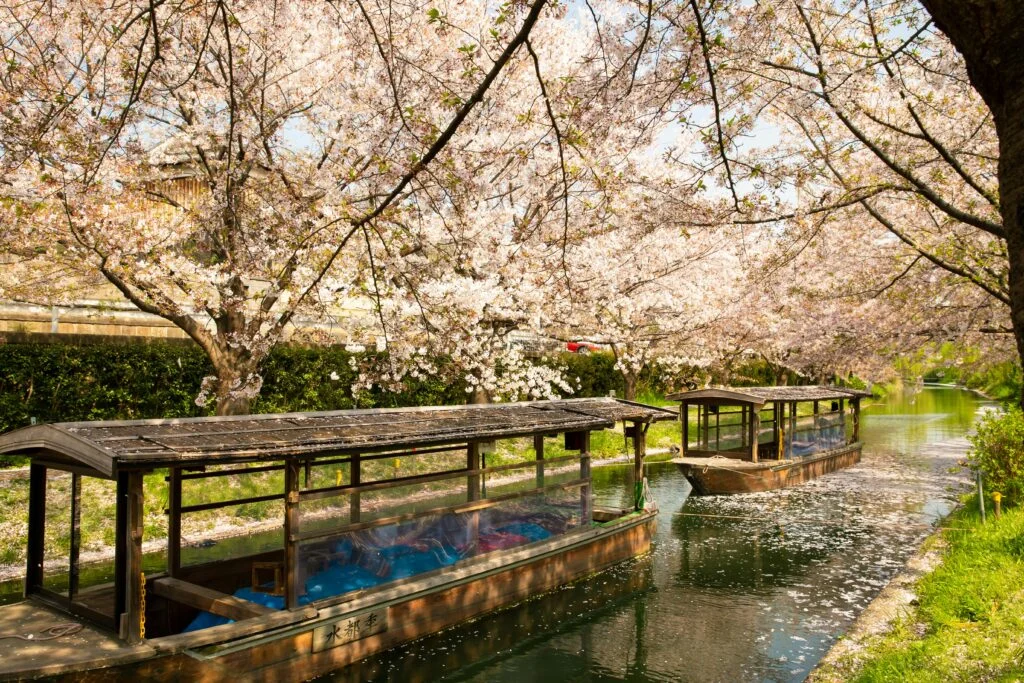
- Northern Japan (Tohoku, Hokkaido): Late April to early May
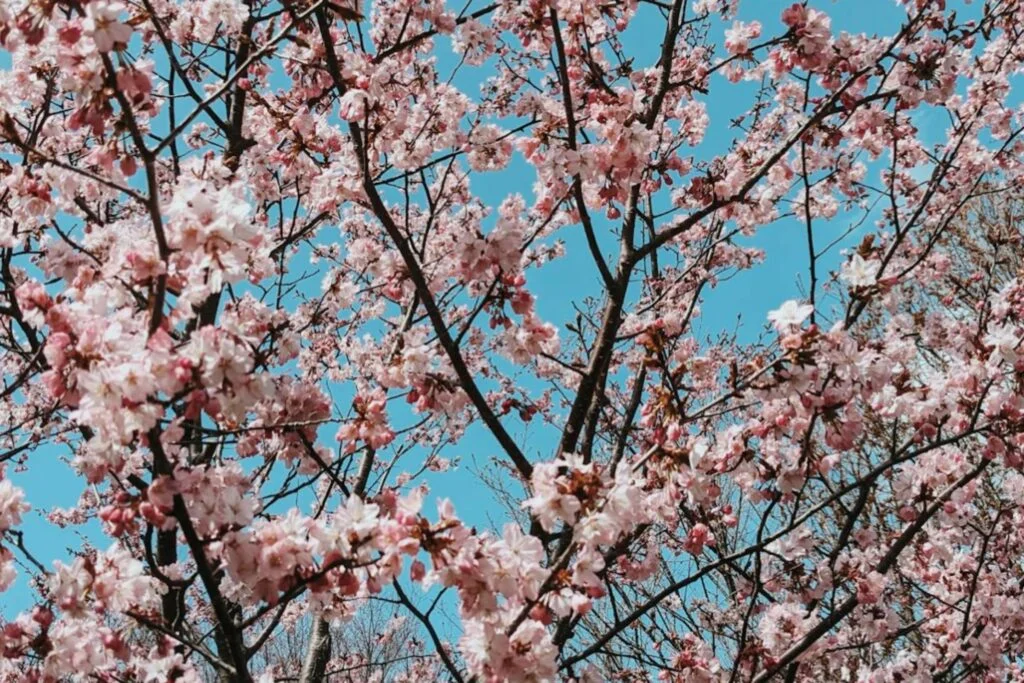
For the quintessential hanami (flower viewing) experience, consider these top spots:
- Tokyo: Ueno Park, Shinjuku Gyoen, Chidorigafuchi
- Kyoto: Philosopher’s Path, Maruyama Park
- Osaka: Osaka Castle Park
- Hirosaki: Hirosaki Castle Park (late April)
- Yoshino: Mount Yoshino (considered Japan’s best sakura spot)
Golden Week Warning: Navigating Japan’s Busiest Holiday
Be aware that Golden Week Japan, a cluster of national holidays from late April to early May, brings massive domestic tourism. During this period:
- Accommodation prices skyrocket
- Transportation is crowded
- Popular attractions become extremely busy
- Advance bookings are essential
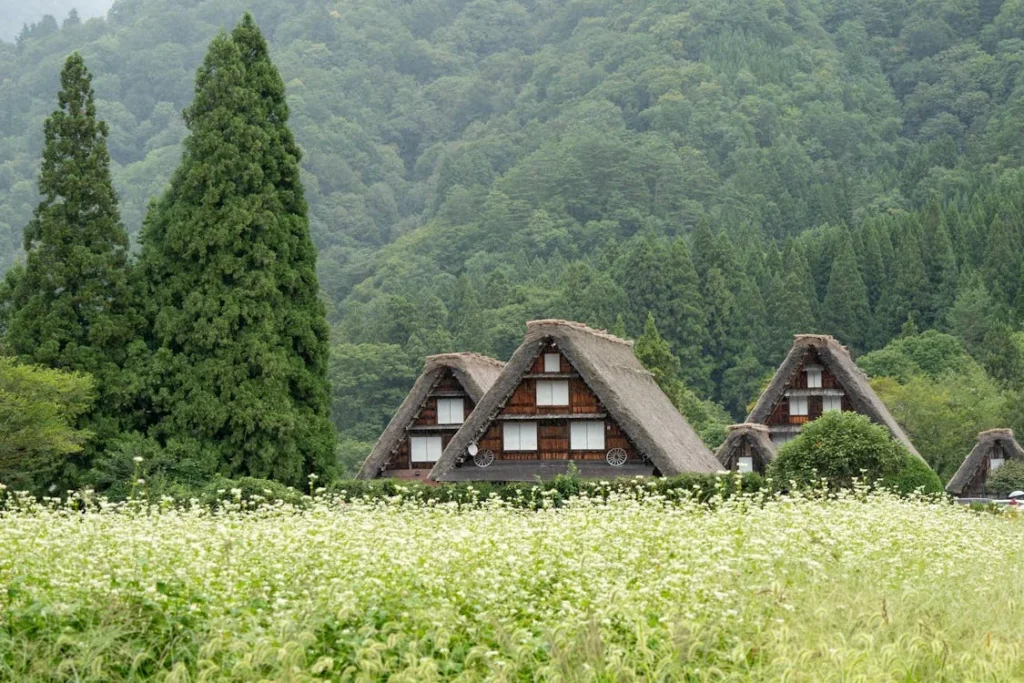
Spring Weather and Packing Tips
Spring weather in Japan is generally pleasant but can be unpredictable:
- Temperature Range: 10-20°C (50-68°F)
- Rainfall: Moderate, with occasional showers
- Packing Essentials: Layers, light jacket, comfortable walking shoes, umbrella
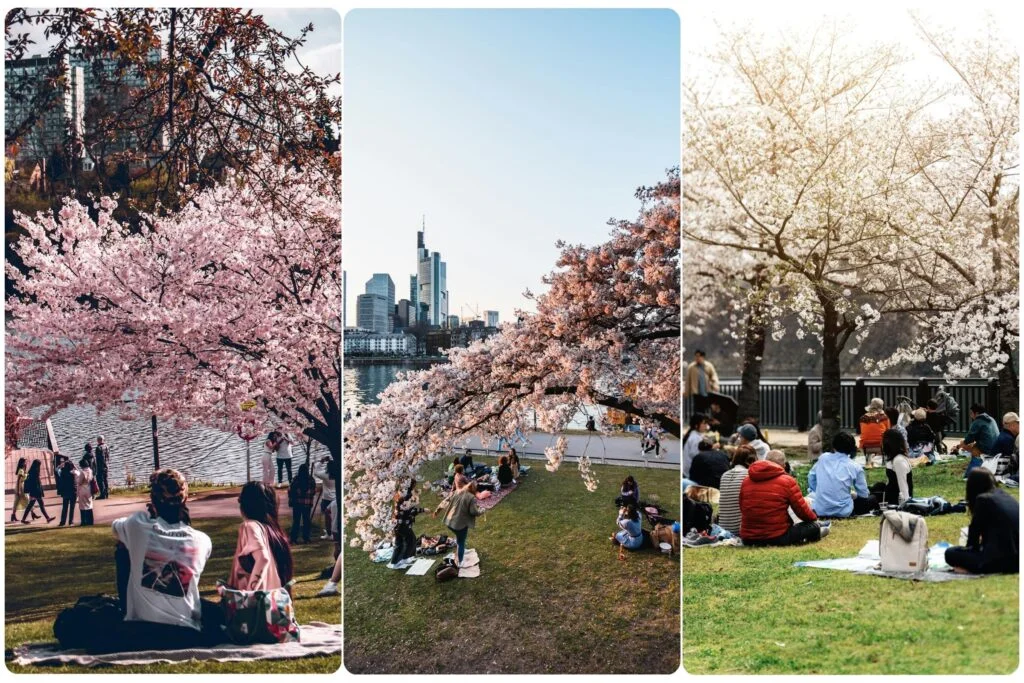
Image: People enjoying hanami picnic under cherry blossom trees in a park
Summer in Japan: Festivals and Outdoor Adventures (June-August)
Summer brings warmer temperatures, lively festivals, and opportunities for outdoor adventures, particularly in Japan’s mountainous regions.
Japan Summer Festivals: Vibrant Cultural Experiences
Summer is matsuri (festival) season across Japan, offering visitors a chance to experience traditional culture:
- Gion Matsuri (Kyoto, July): One of Japan’s most famous festivals featuring massive floats

- Tanabata (Nationwide, July): Star festival with colorful decorations

- Awa Odori (Tokushima, August): Energetic traditional dance festival

- Nebuta Matsuri (Aomori, August): Spectacular illuminated float parade
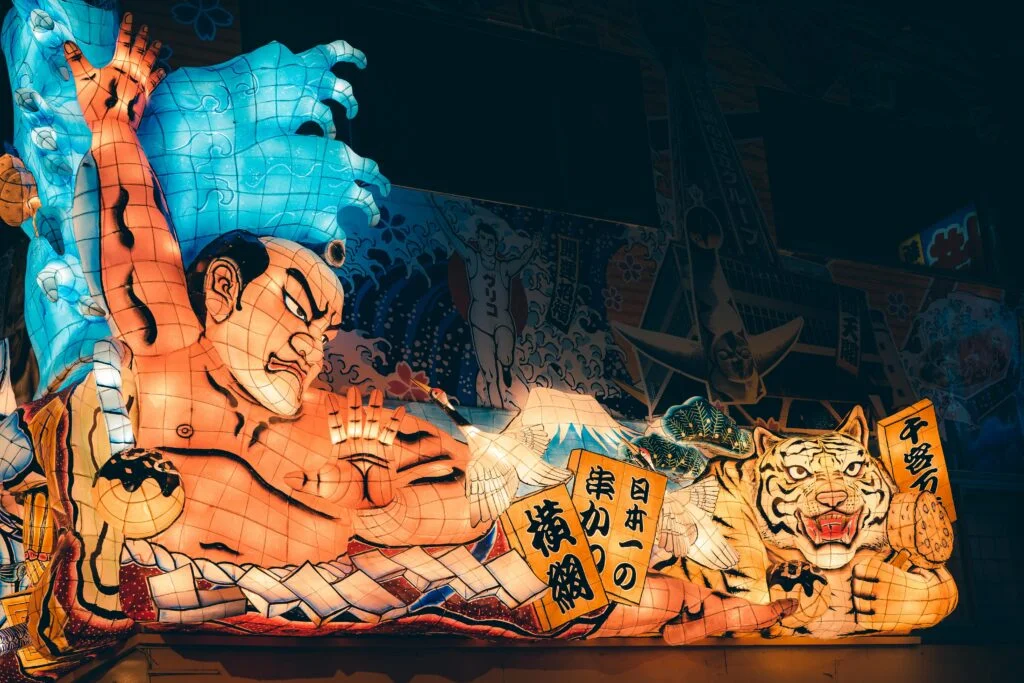
- Sumidagawa Fireworks (Tokyo, July): Dazzling fireworks display over the Sumida River
Navigating Japan’s Rainy Season and Typhoon Considerations
The Japan rainy season (tsuyu) typically runs from early June to mid-July, bringing:
- Increased humidity
- Regular rainfall (though rarely all-day downpours)
- Lush, vibrant landscapes
- Blooming hydrangeas
From August to September, be aware of potential typhoons, particularly in southern regions. Monitor weather forecasts and have flexible plans during this period.
Summer Weather and Packing Tips
Summer in Japan can be hot and humid:
- Temperature Range: 25-35°C (77-95°F), with high humidity
- Rainfall: Heavy during rainy season, then sporadic
- Packing Essentials: Lightweight, breathable clothing, rain gear, portable fan, insect repellent
🌸 Planning for cherry blossom season? Don’t miss the best places to visit in Japan during sakura — the views (and photos) are unreal!
Japan Autumn Foliage: Spectacular Colors and Comfortable Weather (September-November)
Many travelers consider autumn the best time to visit Japan due to comfortable temperatures, clear skies, and spectacular foliage.
Koyo Autumn Leaves Japan: Nature’s Spectacular Show
The koyo autumn leaves Japan experience rivals cherry blossom season in beauty. The colorful transformation begins in late September in Hokkaido and gradually moves southward:
- Hokkaido: Late September to early October
- Tohoku Region: Mid-October to early November
- Tokyo/Kyoto: Mid-November to early December
- Southern Japan: Late November to early December
Top spots for autumn foliage viewing include:
- Kyoto: Tofukuji Temple, Arashiyama, Eikando Temple
- Tokyo: Rikugien Garden, Meiji Jingu Gaien
- Nikko: Lake Chuzenji, Irohazaka Winding Road
- Hakone: Lake Ashi, Hakone Garden
- Miyajima: Momijidani Park
Autumn Weather and Packing Tips
Autumn offers some of Japan’s most pleasant weather:
- Temperature Range: 15-25°C (59-77°F), cooling as season progresses
- Rainfall: Generally low, with clear skies
- Packing Essentials: Light layers, comfortable walking shoes, light jacket for evenings
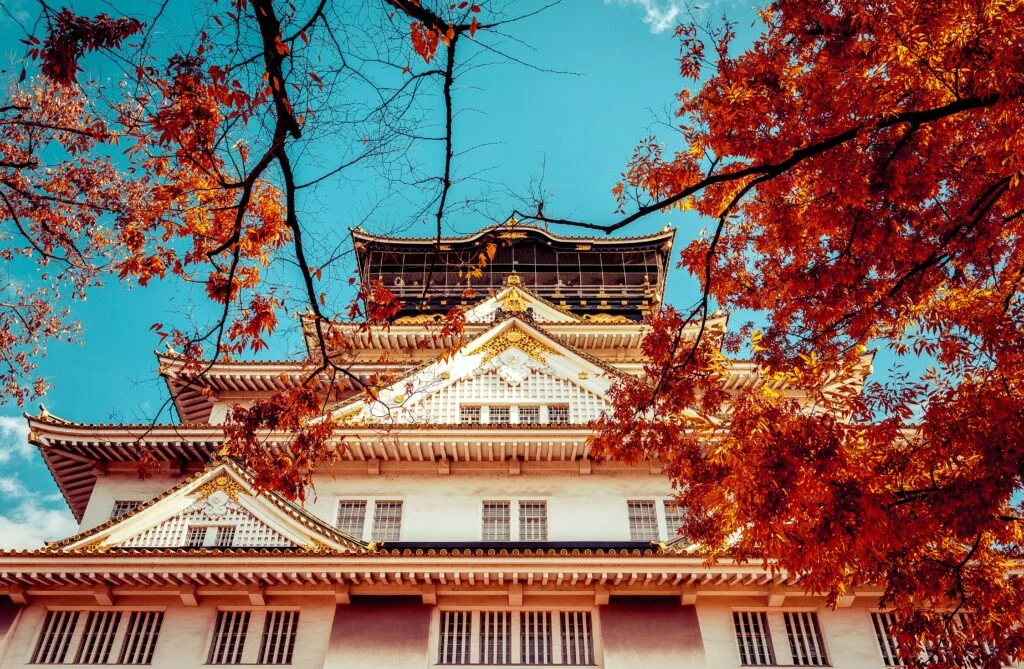
Image: Vibrant red maple leaves at a Japanese temple garden in autumn
🤖 Wondering which plan is best? Compare eSIM providers for Japan here to choose smart
Winter in Japan: Snow, Onsens, and Festive Illuminations (December-February)
Winter transforms Japan into a wonderland of snow, hot springs, and illuminations, particularly in the northern and mountainous regions.
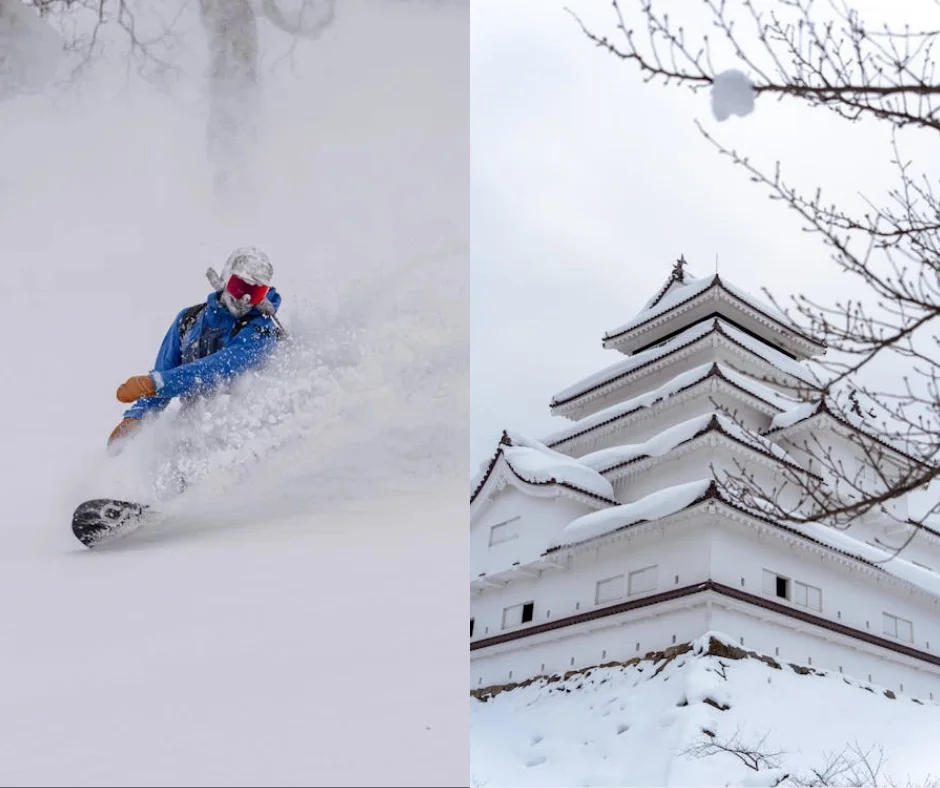
Japan Skiing Season: World-Class Powder Snow
The Japan skiing season attracts powder enthusiasts from around the world, particularly to Hokkaido’s legendary resorts:
- Niseko (Hokkaido): World-renowned for consistent powder snow
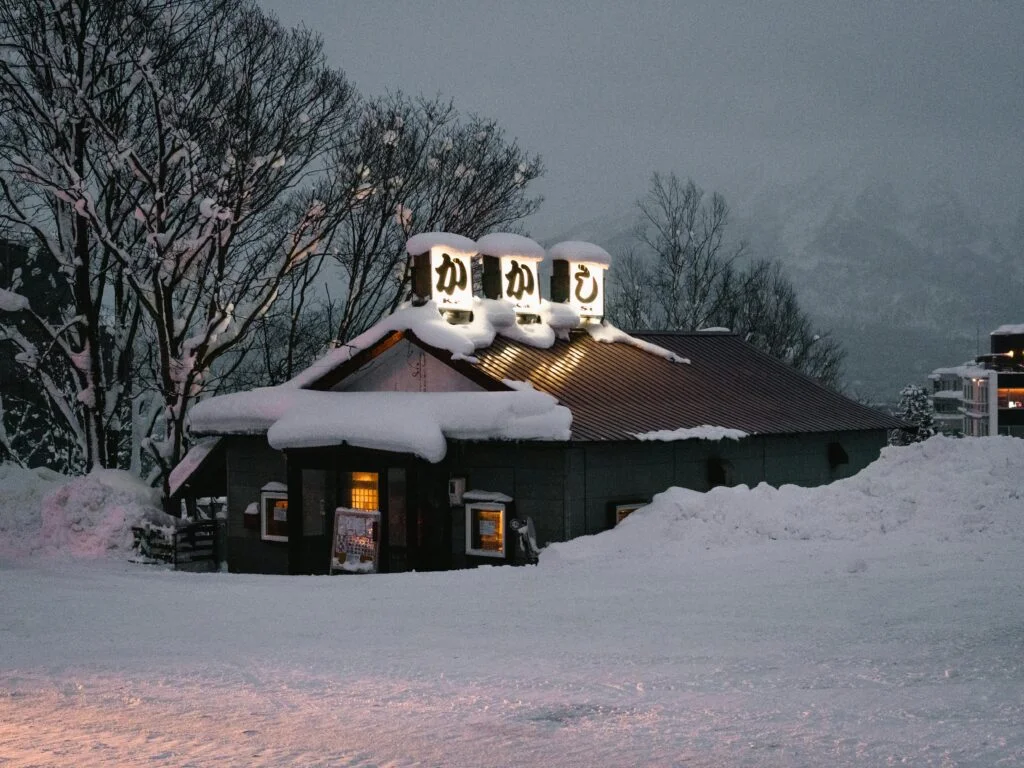
- Hakuba (Nagano): Site of the 1998 Winter Olympics

- Nozawa Onsen: Traditional hot spring village with excellent skiing
- Shiga Kogen: Japan’s largest ski area
- Zao Onsen: Famous for its “snow monsters” (snow-covered trees)

Winter Onsen Experience: Relaxation in Natural Hot Springs
Winter is the perfect time to experience Japan’s onsen (hot spring) culture:
- Kusatsu Onsen (Gunma): One of Japan’s most famous hot spring towns
- Kinosaki Onsen: Traditional town where visitors hop between seven public baths
- Nyuto Onsen (Tohoku): Secluded hot springs in a snowy forest setting
- Ginzan Onsen: Nostalgic hot spring town that’s particularly magical when snow-covered

Winter Illuminations and Festivals
Japan’s cities light up with spectacular winter illuminations:
- Kobe Luminarie: Memorial illumination event
- Nabana no Sato (Mie): Massive light installation at a flower park
- Sapporo Snow Festival: Spectacular snow and ice sculptures
- Otaru Snow Light Path: Charming canal city illuminated by snow lanterns
Winter Weather and Packing Tips
Winter varies dramatically across Japan:
- Temperature Range: -5 to 10°C (23-50°F), colder in the north
- Snowfall: Heavy in northern and mountainous areas, rare in Tokyo
- Packing Essentials: Warm layers, winter coat, hat, gloves, waterproof footwear
🇯🇵 No matter the season, you’ll need the best eSIM for Japan for smooth navigation and instant translations.
II. Regional Guide: Best Times to Visit Different Parts of Japan
Japan’s geography creates distinct climate patterns across the country. Here’s when to visit specific regions for optimal experiences.
Tokyo Best Visiting Months: Year-Round Appeal with Seasonal Highlights
Japan’s capital offers something special in every season:
- Spring (March-April): Cherry blossoms in Ueno Park, Shinjuku Gyoen
- Summer (July-August): Festivals, fireworks displays, summer cuisine
- Autumn (November-December): Colorful foliage in city parks
- Winter (December-February): Winter illuminations, less crowded attractions
Tokyo Insider Tip: Visit mid-week to avoid crowds at popular attractions, and consider early morning visits to places like Meiji Shrine and Sensoji Temple.
Kyoto Seasonal Guide: Timing Your Visit to the Cultural Heart of Japan
Kyoto’s appeal changes dramatically with the seasons:
- Spring (March-April): Cherry blossoms frame temples and shrines
- Summer (July): Gion Matsuri, one of Japan’s most famous festivals
- Autumn (November): Spectacular foliage at temples like Tofukuji and Kiyomizudera
- Winter (December-February): Occasional snow creates magical scenes at temples
Kyoto Insider Tip: The weeks immediately before and after cherry blossom season offer similar beauty with significantly fewer crowds.

Image: Fushimi Inari Shrine’s red torii gates with autumn foliage
Hokkaido Winter Experience: Powder Snow and Winter Festivals
Japan’s northernmost island is a winter wonderland:
- Best Time: December to March for skiing and winter festivals
- Highlights: Sapporo Snow Festival (February), world-class skiing in Niseko
- Activities: Skiing, snowboarding, winter wildlife viewing, onsen

Okinawa Beach Season: Tropical Paradise in Southern Japan
Okinawa offers a completely different Japanese experience:
- Best Time: April to June and September to October for ideal beach weather
- Avoid: Rainy season (May-June) and typhoon season (August-September)
- Activities: Snorkeling, diving, beach relaxation, cultural sites
🎎 Planning around cultural events? Explore Japan’s festivals by month to match your trip with vibrant traditions.
III. Specialized Timing Guide: When to Visit Japan for Specific Experiences
Beyond general seasonal considerations, timing your visit around specific interests can enhance your Japanese experience.
Japan Festival Calendar: Year-Round Cultural Celebrations
Japan’s festival calendar offers unique cultural experiences throughout the year:
- January: New Year celebrations (nationwide)
- February: Setsubun (bean-throwing festival, nationwide), Sapporo Snow Festival
- April-May: Spring festivals celebrating cherry blossoms
- July: Gion Matsuri (Kyoto), Tanabata Star Festival (nationwide)
- August: Obon festivals, Awa Odori (Tokushima), Aomori Nebuta
- October: Jidai Matsuri (Kyoto), Halloween celebrations in Tokyo
- December: Year-end festivals, winter illuminations
Mount Fuji Climbing Season: Scaling Japan’s Iconic Peak
The official Mount Fuji climbing season is limited:
- Season: Early July to mid-September
- Best Time: Weekdays in early July for fewer crowds
- Considerations: Weather can change rapidly; proper equipment is essential
- Alternative: Visit during clear winter days for spectacular views without climbing
Japan Hiking Best Months: Exploring Natural Landscapes
Japan offers excellent hiking opportunities outside the major cities:
- Spring (April-May): Lush greenery, wildflowers, comfortable temperatures
- Autumn (September-November): Spectacular foliage, clear skies, comfortable temperatures
- Popular Trails: Kumano Kodo, Nakasendo Way, Japan Alps, Yakushima
Hiking Tip: Avoid the rainy season (June-July) and peak summer heat (August) for the most comfortable hiking experience.

Image: Hiker on a mountain trail with views of Mount Fuji in the distance
🗼 Visiting Tokyo during your trip? Here’s what to do in Tokyo beyond the tourist checklist.
IV. Practical Considerations for Timing Your Japan Trip
Beyond seasonal highlights, several practical factors should influence when you visit Japan.
Budget Travel Japan Timing: When to Find the Best Deals
For budget travel Japan experiences, consider these money-saving timing strategies:
- Cheapest Months: Late January to February (after New Year’s) and June (rainy season)
- Shoulder Seasons: Late May and late November offer good weather with lower prices
- Avoid: Cherry blossom season, autumn foliage peak, Golden Week, and New Year
Budget Tip: Book accommodations and flights at least 3-6 months in advance for the best rates, especially during popular seasons.
Avoiding Crowds in Japan: Strategic Timing for a More Peaceful Experience
To experience Japan with fewer tourists:
- Avoid Peak Periods: Cherry blossom season, autumn foliage peak, Golden Week, Obon
- Consider Weekdays: Popular attractions are significantly less crowded mid-week
- Early Morning Strategy: Visit major attractions right at opening time
- Alternative Destinations: Explore less-visited regions like Tohoku, Shikoku, or Kyushu
Japan Weather Considerations: Planning Around Climate Patterns
Understanding regional weather patterns helps avoid disappointment:
- Rainy Season: Early June to mid-July in most of Japan (earlier in Okinawa)
- Typhoon Season: August to September, primarily affecting southern regions
- Snow Season: December to February, heaviest in northern Japan and mountainous areas
- Most Reliable Weather: Late autumn (October-November) typically offers clear skies and comfortable temperatures
Staying Connected During Your Japan Trip
Regardless of when you visit Japan, staying connected is essential for navigation, translation, and sharing your experiences.
Connectivity Solutions with Gohub eSIM
Traditional SIM cards can be inconvenient when traveling, especially in a country where language barriers exist. Gohub eSIM offers the perfect solution for travelers to Japan:
- Instant Activation: Get connected immediately upon arrival at Japanese airports
- Reliable Coverage: Stay connected throughout Japan, even in rural areas
- Translation Support: Use translation apps to overcome language barriers
- Navigation: Find your way around Japan’s complex transportation system
- Weather Updates: Check real-time weather forecasts to plan activities
- Social Sharing: Share your Japan adventures instantly with friends and family
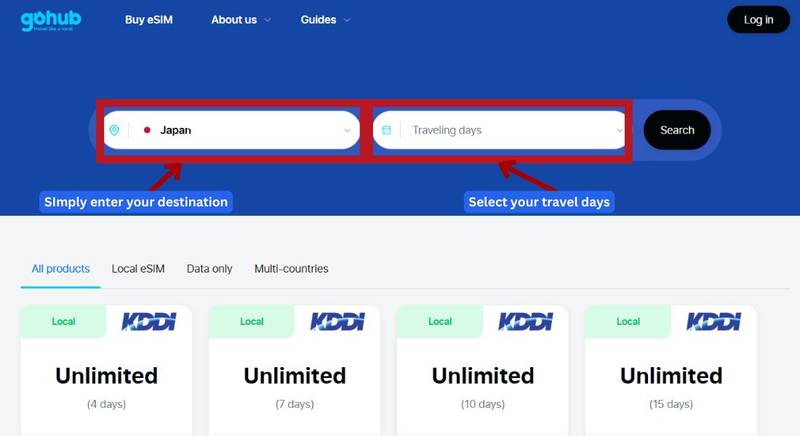
Image: Screenshot of the GoHub eSIM webpage, highlighting the destination input field with “Japan” selected, illustrating how users can easily search for eSIM data plans.
With Gohub eSIM, you can focus on enjoying your Japanese adventure without worrying about connectivity issues or excessive roaming charges.
V. Month-by-Month Guide to Visiting Japan
For those planning a specific month for their Japan trip, here’s a detailed breakdown:
January: New Year Traditions and Winter Landscapes
- Weather: Cold throughout Japan, snow in northern and mountainous regions
- Highlights: New Year celebrations, winter illuminations, fewer tourists
- Considerations: Many businesses close during first few days of January
February: Winter Festivals and Plum Blossoms
- Weather: Still cold, with snow continuing in northern Japan
- Highlights: Sapporo Snow Festival, plum blossoms begin in southern regions
- Considerations: Good value for money, fewer tourists
March: Early Cherry Blossoms and Warming Temperatures
- Weather: Gradually warming, though still cool in evenings
- Highlights: Early cherry blossoms in southern Japan, plum blossoms in central Japan
- Considerations: Increasingly busy as month progresses
April: Peak Cherry Blossom Season and Pleasant Weather
- Weather: Mild and generally pleasant
- Highlights: Peak cherry blossom season in most of Japan
- Considerations: Extremely busy, advance bookings essential
May: Late Spring Greenery and Festivals
- Weather: Warm and comfortable
- Highlights: Lush green landscapes, fewer crowds after Golden Week
- Considerations: Avoid first week (Golden Week) unless you’ve booked well in advance
June: Hydrangea Season and Early Summer Rains
- Weather: Increasing rainfall and humidity as rainy season begins
- Highlights: Hydrangea blooms, fewer tourists, good deals
- Considerations: Pack rain gear, have indoor activity alternatives
July: Festival Season Begins and Summer Heat
- Weather: Hot and humid, rainy season typically ends mid-month
- Highlights: Summer festivals begin, Mount Fuji climbing season opens
- Considerations: Heat can be intense, especially in cities
August: Peak Summer Festivals and School Holidays
- Weather: Very hot and humid, potential typhoons in southern regions
- Highlights: Major summer festivals, Obon celebrations
- Considerations: Domestic tourism peaks during Obon week
September: Cooling Temperatures and Early Autumn Colors
- Weather: Still warm but gradually cooling, potential typhoons
- Highlights: Early autumn colors in northern Japan, fewer crowds
- Considerations: Monitor weather forecasts for typhoon information
October: Comfortable Weather and Spreading Autumn Colors
- Weather: Comfortable temperatures, generally clear skies
- Highlights: Autumn colors in northern and mountainous regions
- Considerations: Increasingly popular month for tourism
November: Peak Autumn Foliage and Crisp Weather
- Weather: Cool but still comfortable, especially early in the month
- Highlights: Peak autumn foliage in most of Japan
- Considerations: Popular season, though less crowded than cherry blossom time
December: Winter Illuminations and Year-End Traditions
- Weather: Cold, with snow in northern and mountainous areas
- Highlights: Winter illuminations, Christmas celebrations, New Year preparations
- Considerations: Businesses may close during last few days of December
🚶♀️ Visiting solo? This solo trip to Japan guide makes planning way easier.
VI. Conclusion: Finding Your Perfect Time to Visit Japan
The best time to visit Japan ultimately depends on your personal preferences, interests, and priorities. Each season offers unique experiences that showcase different aspects of this fascinating country:
- Spring brings the iconic cherry blossoms and comfortable temperatures
- Summer offers vibrant festivals and outdoor adventures
- Autumn showcases spectacular foliage and ideal weather conditions
- Winter transforms the country with snow, hot springs, and illuminations
Consider your budget, tolerance for crowds, and specific interests when deciding when to visit. For first-time visitors seeking a balance of good weather, reasonable prices, and manageable crowds, late autumn (October-November) and late spring (May) often provide the best overall experience.
Whatever season you choose for your Japanese adventure, proper planning and flexibility will help you make the most of your trip. And don’t forget to secure your Gohub eSIM before departure to ensure seamless connectivity throughout your journey.
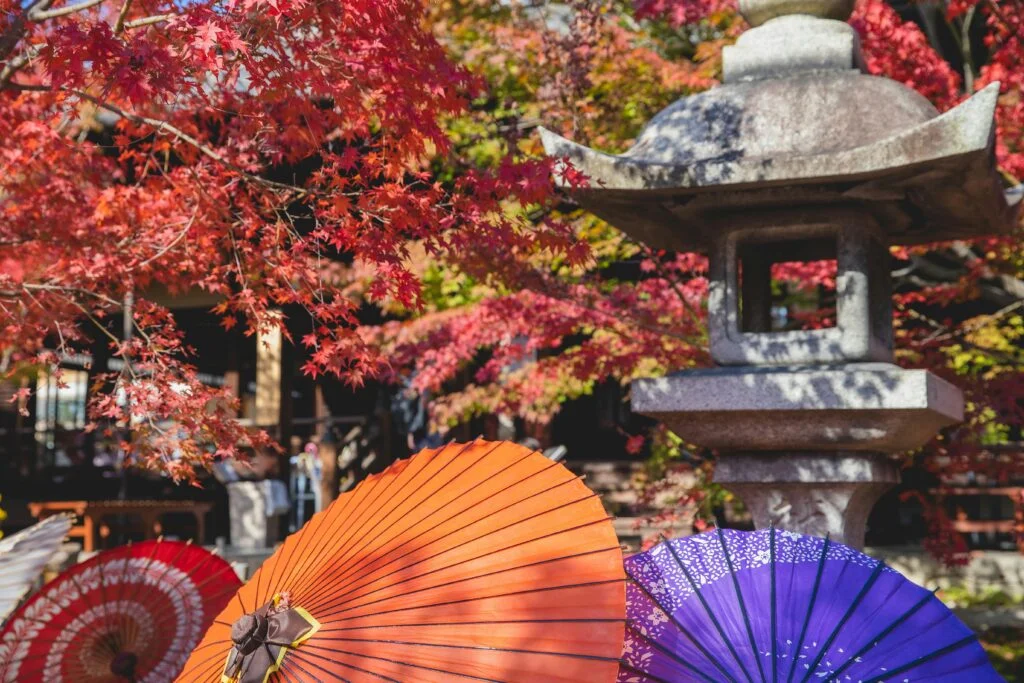
Traditional Japanese garden with maple trees in autumn colors
📶 From Tokyo to Kyoto, stay connected across Japan with a travel eSIM that activates instantly — unlimited data, plus a sweet bonus at Lawson stores 🍡


